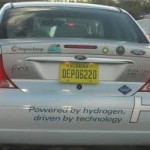
 One day, U.S. roads could hold large numbers of cars and trucks powered by hydrogen, but issues around recharging the hydrogen, or filling the tank, must be addressed.
One day, U.S. roads could hold large numbers of cars and trucks powered by hydrogen, but issues around recharging the hydrogen, or filling the tank, must be addressed.
In a recent study, scientists at Pacific Northwest National Laboratory showed that materials made from abundant and inexpensive metals could recharge an amine borane-based hydrogen storage system.
Millions of dollars are being spent on developing electric vehicles. Electric vehicles, powered by hydrogen fuel cells, provide the demanded driving range and low environmental impact. However, hydrogen fuel cell powered electric vehicles suffer from a refueling problem. The challenge is to recharge the hydrogen safely, quickly and affordably. One way to do this is to store the hydrogen in safe materials that release the hydrogen on demand via simple chemical reactions. The next question is how to put the hydrogen back into the “spent fuel.” Scientists at Pacific Northwest National Laboratory discovered cobalt and nickel complexes that activate hydrogen enabling the spent fuel to be recycled. These metals are not precious metals, which have availability and cost issues. The cobalt and nickel complexes could facilitate efficient and affordable refueling.
“The hardest part is getting the hydrogen back onto the storage material,” said Dr. Tom Autrey, a chemist at PNNL who was involved with the study. “You can’t just pump it back in. So, we needed to develop a chemical process where we can do it cost effectively.”
It’s all about cost and safety. Many processes developed in a laboratory can’t be inexpensively and safely done when taken beyond the laboratory. Chemical hydrogen storage systems that could one day power cars and trucks can be recharged, but the devil is in the details. Current processes require molten sodium, which has safety concerns and cost issues at large scales. In early work, PNNL scientists demonstrated that rhodium complexes could be used, but rhodium is far too expensive. Their recent discovery shows that complexes of cobalt and nickel, abundant and inexpensive metals, could recharge an amine borane-based hydrogen storage system.
The research team developed nickel and cobalt complexes that activate or recharge hydrogen storage material ammonia borane.
The researchers began by studying the underlying mechanics of the reactions. “We took a rational approach—mindful of the chemistry and how it impacts the refueling process,” said PNNL chemist Dr. Michael Mock, who led the study.
“We can’t just pressurize the spent fuel with hydrogen. You have to work with Mother Nature and use a chemical process to put the hydrogen back,” said Autrey.
So, the team performed extensive electronic structure calculations using the NWChem software, previously developed in part at PNNL, to predict the reactivity of a large number of potential reaction schemes. “The calculations let us screen targets fast,” said Dr. Don Camaioni, who led the theoretical portion of the research. “We quickly learned what influenced reactivity and what didn’t.”
With the properties determined, the researchers focused on the synthesis of a select number of cobalt and nickel complexes, benefiting from the use of resources in EMSL. They then analyzed the effectiveness of these complexes in activating hydrogen for transfer to targets molecules identified by computation. The experimental work confirmed that the cobalt and nickel complexes managed the job at reasonable temperatures and pressures.
“There is a lot of balancing required to match the energetics of all the different steps in the hydrogen refueling process,” said Autrey. “This is a very good step forward.”
This work is part broader of efforts at PNNL to answer the fundamental questions around molecular catalysis. For example, Mock is taking on a larger challenge in the Center for Molecular Electrocatalysis, a DOE Energy Frontier Research Center at PNNL. He will soon be solving fundamental questions around the complex multi-electron reduction that takes nitrogen gas to ammonia for fertilizer. Camaioni and Autrey are using the insight gained from these studies to investigate the potential of using non-metal complexes to catalytically activate hydrogen for energy storage applications.



